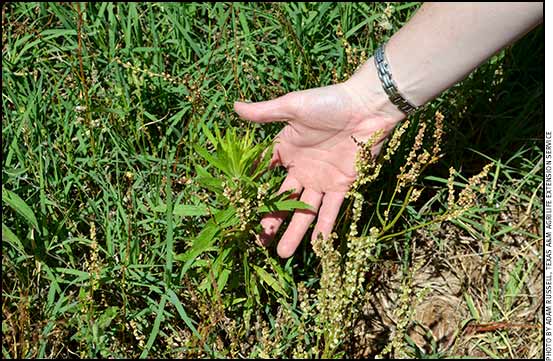
Vanessa Corriher-Olson, AgriLife Extension forage specialist, points out Horseweed, a green, leafy warm-season annual plant, and Red Sorrel (to the right of her hand,) a cool-season perennial plant, in Coastal Bermuda grass. Seasonal weeds are converging in ranges and pastures around the state.
Forage Producers Face Annual
Battle with Weeds
Identifying weeds is the first step to controlling growth.
It’s an annual battle to address range and pasture weeds, said a Texas A&M AgriLife Extension Service expert.
Cool-season weeds have fully matured, and warm-season weeds are emerging amid wet spring conditions and creating problems for some forage producers, said Vanessa Corriher-Olson, AgriLife Extension forage specialist in Overton.
The wet weather in East Texas and other parts of the state is also preventing producers from entering fields with equipment to fight unwanted plants, she said. Bermuda grass is starting to grow, but recent cooler temperatures have slowed its progress in some areas and provided growth opportunity for weeds.
These weeds compete with forages like Bahia grass and Bermuda grass for moisture and nutrients from fertilizer, she said. Their presence can also reduce forage quality. Some weeds are toxic to livestock.
Corriher-Olson said the best way to beat back weeds is to promote forage growth. It starts with the soil pH balance and fertilizing according to soil analysis and the needs of desired forages.
Herbicides are an effective option for weed control when applied correctly, she said. Identifying the weed is the most important consideration when applying herbicides.
Plant type determines the most effective control approach, she said. Determining if the weed is a perennial or annual plant and the most effective time to spray are critical to successful application.
“There’s a wide variety of herbicides for pastures and hay meadows,” she said. “It can be hard to make a decision. Once we’ve identified the plant, we can find the best recommendations.”
The plant varieties in Texas are so vast, Corriher-Olson said, even knowledgeable forage producers have identification questions. She said photographs or fresh plant samples can help AgriLife Extension agents and specialists determine what landowners are dealing with.
Mowing can reduce the presence of unwanted plants, but it’s not the most economical or effective control method, she said. It takes several cuts throughout the year to control or eliminate weeds by mowing. Forages are also mowed down with each cutting.
Corriher-Olson said there are also several excellent websites, including online AgriLife Extension and Texas A&M AgriLife Research publications, and books that help identify weeds found in Texas. Toxic Plants of Texas, Brush and Weeds of Texas Rangelands and Know Your Grasses are all available on the AgriLife Bookstore website at www.agrilifebookstore.org.

Editor’s Note: Adam Russell is a communications specialist with Texas AgriLife Communications.






